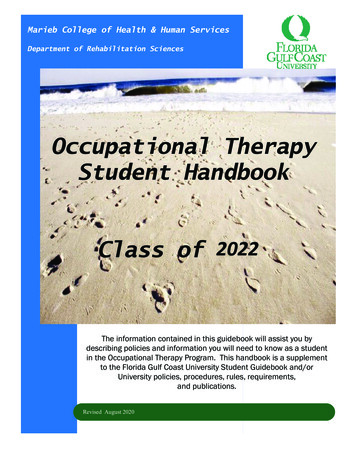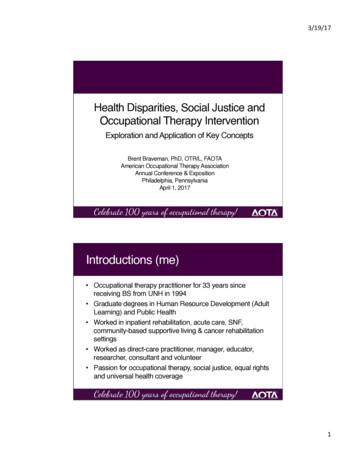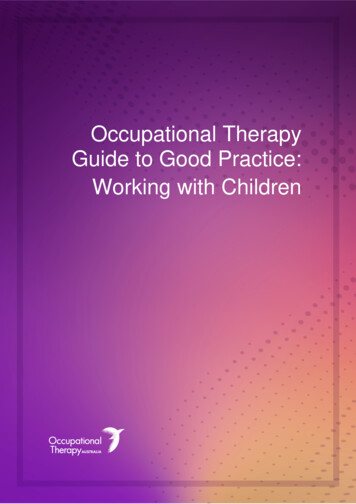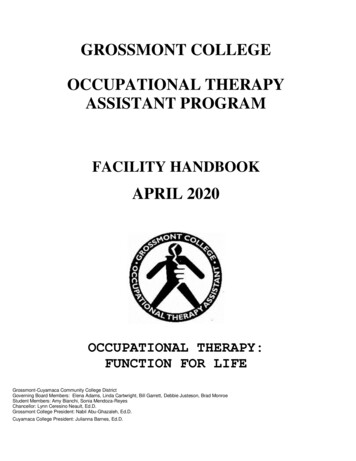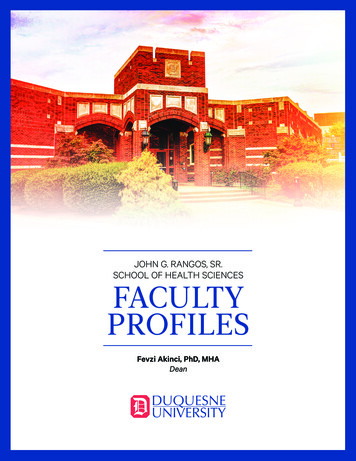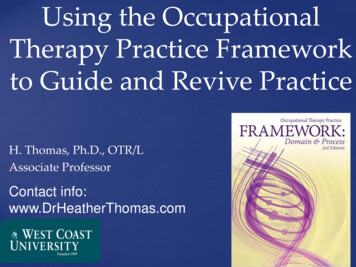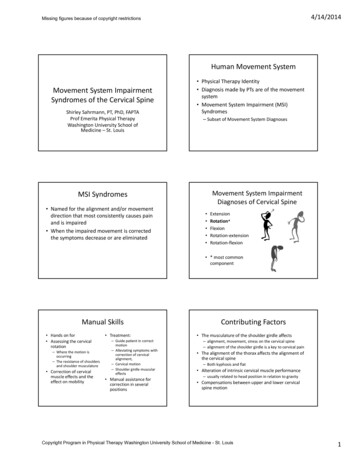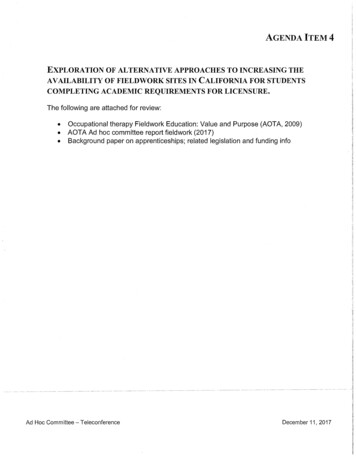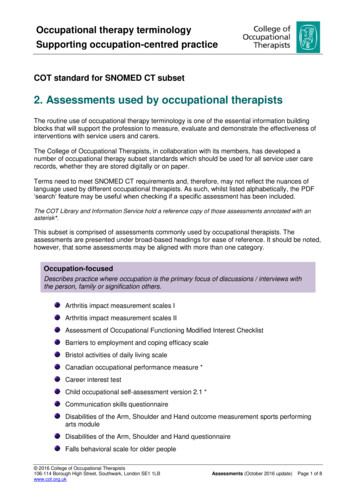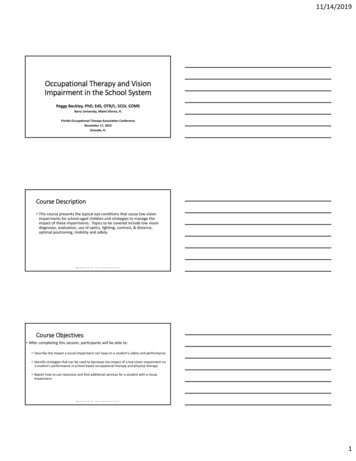
Transcription
11/14/2019Occupational Therapy and VisionImpairment in the School SystemPeggy Beckley, PhD, EdS, OTR/L, SCLV, COMSBarry University, Miami Shores, FLFlorida Occupational Therapy Association ConferenceNovember 17, 2019Orlando, FLCourse Description This course presents the typical eye conditions that cause low visionimpairments for school‐aged children and strategies to manage theimpact of these impairments. Topics to be covered include low visiondiagnoses, evaluation, use of optics, lighting, contrast, & distance,optimal positioning, mobility and safety.Peggy Beckley, PhD, EdS ‐‐ Barry University, Miami Shores, FLCourse Objectives After completing this session, participants will be able to: Describe the impact a visual impairment can have on a student’s safety and performance Identify strategies that can be used to decrease the impact of a low vision impairment ona student’s performance in school‐based occupational therapy and physical therapy Report how to use resources and find additional services for a student with a visualimpairment.Peggy Beckley, PhD, EdS ‐‐ Barry University, Miami Shores, FL1
11/14/2019Peggy Beckley, PhD, EdS ‐‐ Barry University, Miami Shores, FLLow Vision and Legal Blindness Low Vision Cannot be corrected with lensesor surgery Visual Acuity: 20/70 – 20/200 Loss in central or peripheral fieldsthat effects both eyes Legal Blindness Visual Acuity: 20/200 or worse inthe better eyes and a visual fieldless than 20 degreesWhitaker et al 2017Peggy Beckley, PhD, EdS ‐‐ Barry University, Miami Shores, FLFour Most Common Causes of Low VisionGlaucomaDiabetic RetinopathyPeggy Beckley, PhD, EdS ‐‐ Barry University, Miami Shores, FL2
11/14/2019(cont’d)CataractsMacular DegenerationPeggy Beckley, PhD, EdS ‐‐ Barry University, Miami Shores, FLCauses of Visual Impairment in Young ChildrenAcquired Pediatric EyeConditions Infection Toxoplasmosis Cytomegaloviral (CMV) Herpes Retinopathy of Prematurity (ROP) TraumaPogrund & Fazzi, 2002Congenital Pediatric EyeConditions Albinism‐ Microthalmia Amblyopia‐ Myopia Aniridia‐ Nystagmus Congenital Cataracts‐ Retinitis Pigmentosa CHARGE Syndrome‐ Retinoblastoma Coloboma‐ Strabismus Cortical Visual Impairment ‐ Glaucoma Optic Nerve Hypoplasia‐ HemianopiaPeggy Beckley, PhD, EdS ‐‐ Barry University, Miami Shores, FLExpressions of Low VisionChallenge with ContrastDecreased Visual AcuityPeggy Beckley, PhD, EdS ‐‐ Barry University, Miami Shores, FL3
11/14/2019(cont’d)Limited Light Reaching RetinaToo Much Light Reaching RetinaPeggy Beckley, PhD, EdS ‐‐ Barry University, Miami Shores, FL(cont’d)Decreased Visual FieldsPeggy Beckley, PhD, EdS ‐‐ Barry University, Miami Shores, FLExpressions of Visual Impairment . Often decreases ability torecognize faces, read, locate alandmark May limit ability to anticipatewhat/who may be approaching,decreasing time to react toobject or person Can cause challenges in posturalcontrol and balancePeggy Beckley, PhD, EdS ‐‐ Barry University, Miami Shores, FL4
11/14/2019Considerations for Intervention Obtain the latest ophthalmology/optometry report for student Impact of co‐morbid conditions/diagnoses Interests of student/parents related to functional skills IEP goals Low Vision resources available in school, local community, region, state Assess impact of low vision impairment on performance in OT Knowing what you know about the student’s visual acuity, visual field, cognitiveskills, and postural control, how does visual impairment impede progress?Peggy Beckley, PhD, EdS ‐‐ Barry University, Miami Shores, FLConsider Impact of Low Vision Impairment(LVI) on Students’ Safety Mobility in classroom, hallways, cafeteria, playground Orienting to location in building and finding way to destination Locating items in classroom, gym, cafeteria Identifying hazardous situations/materials Identifying objects in pathway Identifying stairways, curbs Judging distance on playground equipment Awareness of moving objects and people in team games, sportsPeggy Beckley, PhD, EdS ‐‐ Barry University, Miami Shores, FLConsider Impact of LVI on Typical School andTherapy Tasks ReadingWritingExploring learning objects and playing with toysComputer ScreenComputer OperationEating LunchHygieneGroup ActivitiesTool manipulation – devices (calculator, etc), paint brushes, crayons,utensils, scissorsPeggy Beckley, PhD, EdS ‐‐ Barry University, Miami Shores, FL5
11/14/2019Strategies to Decrease Impact of LVI onSchool‐based OT Important to consider: Light Contrast Distance MagnificationPeggy Beckley, PhD, EdS ‐‐ Barry University, Miami Shores, FLLighting Shadows Low Light Uncontrolled Light/Glare Changes in Light based on Timeof Day Effects of Moving from Light‐to‐Dark and Dark‐to‐Light Directing Light Illuminating pathwaysPeggy Beckley, PhD, EdS ‐‐ Barry University, Miami Shores, FLContrast Black on white is often easiest forreading and writing Light object, use dark background andvice versa (therapy room, classroom,lunch room) Contrasting tape for light switches,keyboard, placement of materials Dark or bright tape in bathroomwhere fixtures are often white Place contrasting strip on first/laststeps in staircase Create contrast for indoor/outdoorenvironments where there are similarcolors in the terrain, buildings, andobjectsPeggy Beckley, PhD, EdS ‐‐ Barry University, Miami Shores, FL6
11/14/2019Distance Reading materials and othertherapy objects often need to bemoved closer to client/the eyes Signage or classroom smartboard need to be read fromcloser proximity Optics for distance – variousviewing distances Optics to increase field of view –decrease detail of objects in fieldPeggy Beckley, PhD, EdS ‐‐ Barry University, Miami Shores, FLMagnification Enlarge print on therapy hand outs Use of large print books Use of hand‐held optical magnifiers Use of electronic magnifiers iPad features for magnification canwork for some students Consideration of motor skills,cognitive skills, and resources toaccess devicesPeggy Beckley, PhD, EdS ‐‐ Barry University, Miami Shores, FLOther Considerations for Supporting Studentswith LVI Continued professionaldevelopment in area of LVI Referral tooptometrist/ophthalmologist Request for Functional VisualAssessment from a TVI or COMS Include specified visualscreening or assessment in OTevaluationPeggy Beckley, PhD, EdS ‐‐ Barry University, Miami Shores, FL7
11/14/2019Resources and Services for Students with LVI Teacher of Visually Impaired (TVI) Certified Orientation & Mobility Specialist (COMS) Optometrist/Ophthalmologist Florida Division of Blind Services http://dbs.myflorida.com/Resources/Organizations/ Independent Living Aids, LLC http://www.independentliving.com/ MaxiAids – Low Vision Products https://www.maxiaids.com/low‐vision‐products Perkins http://www.perkinsproducts.org/store/en/Peggy Beckley, PhD, EdS ‐‐ Barry University, Miami Shores, FLQuestions or Comments?Peggy Beckley, PhD, EdS ‐‐ Barry University, Miami Shores, FLReferences Geruschat, D.R., Smith, A.J. (2010). Improving the use of low vision for orientation andmobility. In Wiener, W.R., Welsh, R.L., & Blasch, B.B. (Ed.) Foundations of Orientation &Mobility, Vol. II: Instructional Strategies and Practical Applications, 3rd ed., New York:AFB Press. Greer, R. (2004). Evaluation methods and functional implications: Children and adultswith visual impairments. In Lueck, A. H. (Ed.) Functional vision: A practioner’s guide toevaluation and intervention, New York: AFB Press. Koenig, A.J., Holbrook, M.C., Corn, A.L., DePriest, L.B., Erin, J.N. & Presley, I.(2000). Specialized assessments for students with visual impairments. In Koenig, A.J.,Holbrook, M.C. (Ed.) Foundations of Education, 2nd ed., Volume II InstructionalStrategies for Teaching Children and Youths with Visual Impairments, New York:AFBPress. Pogrund, R.L, Fazzi, D.L. (2002). Early focus: Working with young children who are blindor visually impaired and their families, 2nd ed., New York:AFB Press Whittaker, S., Scheiman, M., Sokol‐McKay, D. (2016). Low vision rehabilitation: Apractical guide for occupational therapists, 2nd ed., Thorofare, NJ:SLACK, Inc.Peggy Beckley, PhD, EdS ‐‐ Barry University, Miami Shores, FL8
11/14/2019Contact Information Peggy Beckley, PhD, EdS, OTR/L, FAOTAAssociate Professor Barry UniversityOccupational Therapy ProgramCollege of Nursing & Health Sciences11300 NE 2nd AvenueMiami Shores, FL 33161 mbeckley@barry.edu 305‐981‐5122Peggy Beckley, PhD, EdS ‐‐ Barry University, Miami Shores, FL9
11/14/2019 1 Occupational Therapy and Vision Impairment in the School System Peggy Beckley, PhD,
